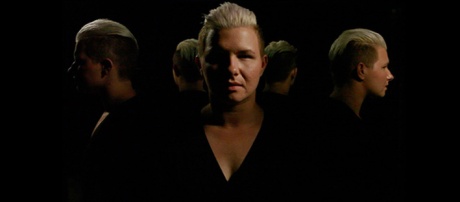I See Queer People
Three Exhibitions
10-25 February 2017
All Welcome

Images (clockwise from top left): Kieran Butler, A self-portrait for you, for me, for yoooo, for M and A and Gee too. 2016, Digital image file. Courtesy of the artist. Danica Knezevic, Constant Reflections, 2013, single channel, HD video. Courtesy of the artist. Tim Hilton/Ladonna Rama. Courtesy of the artist. Phil Soliman, The Vast Interior (View from the cave of St Anthony the Great), digital photograph. Courtesy of the artist.
AirSpace Projects
10 Junction Street, Marrickville
Just 6 minutes easy walk from Marrickville Station
Opening Event
Friday 10 February 6-8pm
Artist Talks
As part of the
Sydney Gay and Lesbian Mardi Gras Festival 2017
Saturday 25 February 3-5pm
Gallery One
Boys don’t cry
Kieran Butler
Boys don’t cry is a tragic love story, a casual hook-up and an awkward first time. It’s all the feelings you couldn’t say, the coming out you never always wanted and a person you thought you could fall in love with.
Boys don’t cry is about the materialities of love and relationships, the 21st century’s constant stream of information, and the way their associated power relations aid the breakdown and construction of one’s own identity. This exhibition is one instance of how we might work through the endless experiences of being under construction, the questions we ask, the self-doubt we face, the love we feel and the places, real, imagined, semi-fictional or fluid it may take us to; online or offline.
For myself, as a gay man, this has been a long, enduring and seemingly lonely experience, a slow construction of my own identity full of self-doubt. I ask myself questions about masculinity, femininity, LGBTQI colloquial language and popular culture; things I don’t understand, things I want to reject/accept, things I’ve felt removed from yet so close to at the same time. In the digital age materiality points to a mess of diverse factors where materiality itself can be an effect of “an ongoing performance”.[1] In this work I am referring to my own ongoing unsuccessful and semi-fictional performances of love as a homosexual, the identity politics of my own socio-political context and how I navigate them.
I am not the first to say boys don’t cry and this exhibition is by no means definitive of LGBTQI experiences. It is merely one of the many stories that exist in spaces that are real and tangible, sometimes imagined, semi-fictional and fluid.
[1] Lange Berndt, P. Documents of Contemporary Art: Materiality, MIT Press, London, 2015, pg.12
Gallery Two and The Cranny
Disco Infirmo
Trevor Fry
Tina Havelock Stevens
Danica Knesevic
Renny Kodgers
Ladonnarama
Sean Lowry
Daniel Mudie Cunningham
Jane Polkinghorne
Ingrid Stiertzel
Curated by Jane Polkinghorne
Disco conjures a nostalgically, shiny, glamorous past while simultaneously suggesting disco’s collapse into a sparkling hole of excess and ridicule.
Disco Infirmo uses disco in the Australian context as its starting point, remote from the high glamour of the disco era at its peak at Studio 54, New York Operating from Australian vernaculars of ‘secondhandism’, the artists incorporate and infect this imported form, corrupting, mutilating and lionising via Australian cultural anti-glamour.
The artists respond to the sensations that Disco Infirmo evokes – nostalgia, sparkles, nausea, dance fails, Blue Light Discos, ridiculous fashion, rhythmic music, those too old for the dance floor, the bad and almost good dancers, Aussie pub rock discos, and mum and dad dancing inappropriately. Out of time and out of place, and yet the disco continues to be a democratic field for creative expression.
Deep Space
Worse than Animals
Phil Soliman
In Worse than animals, Melbourne-based multidisciplinary artist Phil Soliman takes the worst insult he has ever endured and shapes it into a powerful symbol of identity. A gloriously psychedelic mashup of pop culture, internet ephemera, ancient Egyptian mythology and house music, this video installation challenges toxic homophobia and other types of othering with humour and insight.




